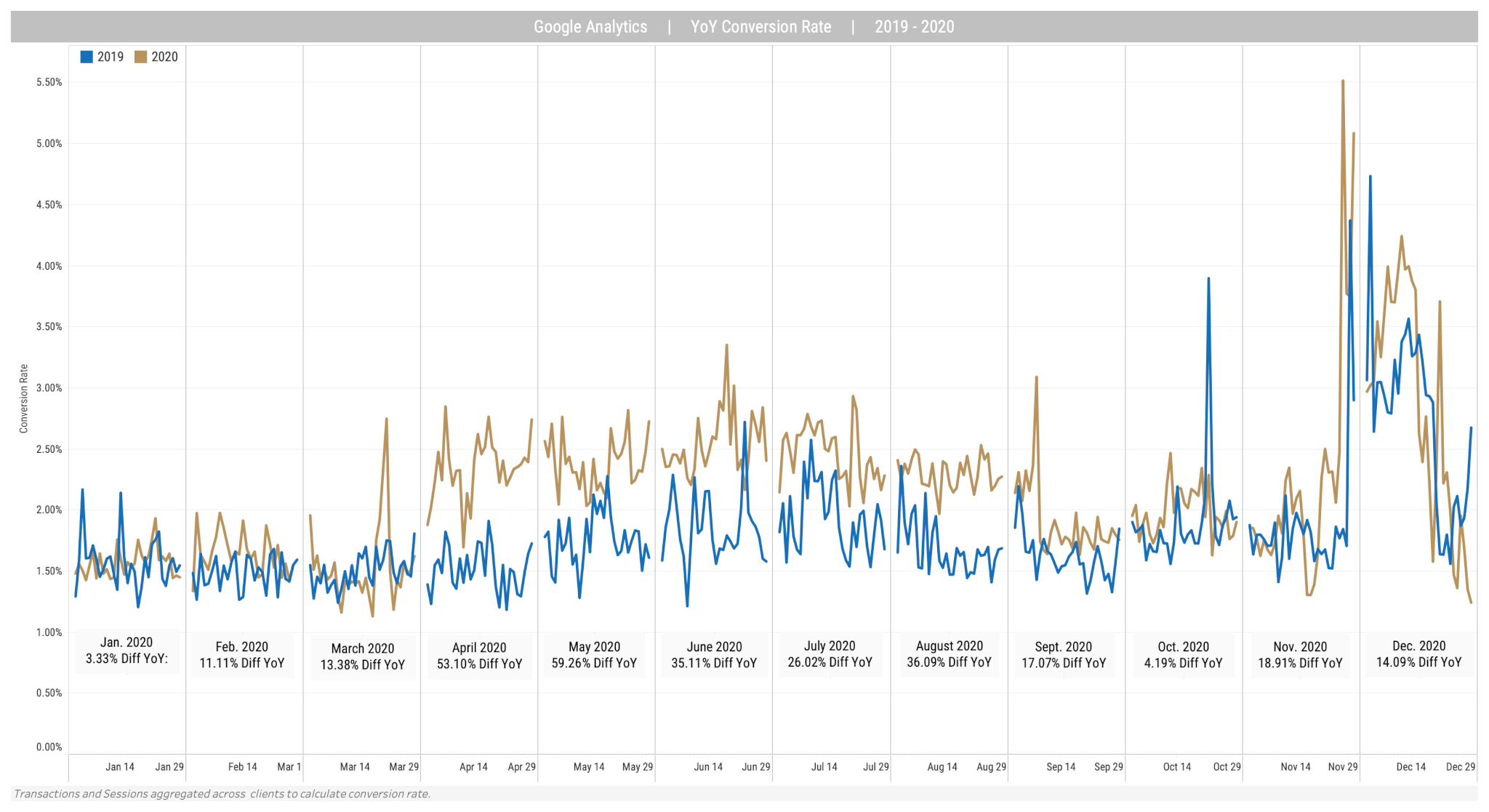The Year(s) of Acceleration: 2020 Media Trends

As we head into the new year and survey all that occurred over the past 12 months, Backbone has identified a number of media trends worthy of keeping an eye on as we strategically plan for 2021. The unprecedented nature of 2020 events have, surprisingly or unsurprisingly, accelerated many media developments despite the glacial pace of quarantine.
Paid Media
Staying nimble is the name of the game in the paid media ecosystem coming out of 2020. As reported mid-year, overall media consumption and e-commerce behavior drastically shifted in 2020, which was directly reflected in our media recommendations. We do not expect this trend to slow down in 2021.
First and foremost, e-commerce is booming: consumer purchase behavior has shifted to online and, even with the option of in-store shopping, we continue to see this pattern with a 17% increase in e-commerce conversion rate year-over-year.
Due to this behavior change, we are putting a premium on the online user experience and the digital media that supports it. It’s a dance of creating demand through meaningful prospecting efforts anchored in quality content while harvesting that demand through hard-working performance media. We expect paid search, shopping, paid social, Amazon marketing and data-driven display and video to continue to be priorities in order to capitalize on the booming e-commerce demand.
Conversely, traditional media has taken a hit:
Inner-city and business-district out of home is a lower priority as fewer people are commuting. However, high-travel road-trip corridors are still experiencing advertiser demand because more people are hitting the road instead of air for travel. Furthermore, with the spike in participation in outdoor activities, these more rural interstate placements are more relevant than ever.
Linear TV continues to see subscribers cutting the cord to participate in on-demand streaming services (connected TV/OTT). As media consumption behavior has shifted, consumers are prioritizing relevant, quality content that they can play at any given time. We view recent developments in connected TV technology as an inflection point: the proliferation of smart TVs in American households now puts connected TV’s reach at a scale rivaling that of linear TV. According to Roku, they are now able to reach four out of five U.S. households with programmatic OTT inventory across all major ad-supported connected TV platforms. That scale, combined with more sophisticated targeting and remarketing capabilities, means that connected TV is no longer merely a means of reaching cable cutters.
The belt has been tightened on print publications as we saw a number of consolidations in the industry, cutting book frequencies and decreasing overall distributions. This has been offset by the increase in online media consumption as many publishers have experienced a surge in site traffic.
But some progressive publishers have begun to make greater investments in their first-party data platforms to enhance their ability to segment ad campaigns in a more sophisticated way. “There is no survival for publishers without first-party data,” according to Robin Thurston, CEO of Pocket Outdoor Media. “Pocket has made significant investment in re-platforming digital properties in an effort to syndicate personalization. This has proven the hypothesis that outdoor enthusiasts participate in three or more activities, and by having first-party data, we can personalize the experience and brands can speak to users where they want to be spoken to.”
Earned Media
PR may look different these days, but it still remains a strong and effective channel to drive indispensable third-party validation.
Throughout the past handful of years, we have observed a shift in the earned media landscape to prioritize SEO and affiliate links. 2020 expedited this trend. As e-commerce has been on the rise, affiliate has become a necessity for any product-centric story. SEO has also become an integral part of publisher content: as most consumer journeys now begin with a Google search, publishers craft their content to rise to the top of the SERP. This is forcing our earned media team to think strategically about pitch lists and what defines a successful PR hit.
Marrying affiliate and SEO with earned media opens up the door to conversion and revenue tracking — the “Holy Grail” of PR measurement. Although PR metrics and ROI data are still not as robust as what’s available for paid media, Backbone continues to invest and improve our PR reporting. Metrics like domain authority, article impact and SERP score allow us to put a data-driven strategy behind PR. Ultimately, we’re getting closer to defining what conversion means to PR as we can start to attribute sales directly to an earned media story.
Despite PR’s recent orientation towards mid- and lower-funnel tactics as described above, earned media remains the most effective vehicle for building brand awareness and exposure among expansion audiences. Editorial coverage from trusted publishers is a uniquely effective, authentic and resilient means of bringing new people into a brand for the long haul, going beyond the click or the purchase event. No matter how enticing it is to funnel investment into channels with clear-cut sales attribution and return on ad spend, word-of-mouth validation from influential publications is essential to building brand love and buzz over time.
Affiliate Marketing
Living at the intersection of paid and earned media, affiliate marketing is arguably experiencing the largest and fastest growth across all media channels. Simply put, consumer product research behavior continues to focus on editorial recommendations, and affiliate is there to capture demand and monetize it.
Over the past several years, accelerated growth of affiliate marketing has been fueled by the increase in DTC e-commerce. Over the past 12 months in particular, affiliate has benefited from the surge in e-comm demand, in part helping brands make up for the drop in wholesale revenue experienced in 2020. On average, Backbone’s clients’ revenue was split 20-30% DTC and 70-80% wholesale revenue going into 2020. Through the hardships of 2020, brands needed to close the gap from loss of wholesale business, and affiliate proved to be an effective lever to pull in order to help increase overall e-comm business.
Furthermore, with the shifts in content consumption, affiliate opportunities provided a mutually beneficial relationship for brands and publishers through the revenue-share model.
Community Management and Influencer Marketing
It was not long ago that influencers and social media ambassadors were viewed as a dying trend. Influencer content came off as inauthentic, money-backed recommendations, and consumers were calling “BS.” In 2020, however, Backbone Media experienced a surge in influencer marketing (expected 15-20% growth in influencer spend 2020 versus 2021), and we only expect this channel to continue to grow and maintain its place as a key, and increasingly trusted, part of the overall media mix.
There are three primary factors that are driving this growth:
- The need for human connection in 2020 accelerated the interest in influencer content and social media personalities. Consumers have resorted to their screens to make emotional connections that previously happened in-person with family and friends. Backbone has found success for our clients by forging authentic connections within an influencer mix that can both amplify heat moments and establish long-term ambassador relationships.
- Advances in technology, amplification and connectivity have created a trifecta for fueling the growth of influencer marketing. The Branded Content Tag and similar technologies enable cross pollination and democratize the platform, allowing brands to have control and take advantage of a 360-degree approach to social media (paid, organic and content curation).
- Comfortability is increasing and understanding of the influencer channel is maturing. Both brands and consumers are accepting the money-backed nature of influencer marketing to a greater degree than we’ve observed in the past.
For our clients, follower size is no longer a vanity metric. Backbone is noticing a shift in consumer brand-discovery behavior as younger demographics are turning to social pages rather than search platforms for their first interaction with a brand. Therefore, follower count legitimizes your brand among prospects, and putting an emphasis on quality content to incentivize a follow is worth the investment.
Backbone Media
The lines between media continue to blur, the marketing channels available to marketers continue to multiply, and new technology is both enabling greater sales attribution and generating higher levels of consumer trust. In today’s media landscape, brands need to be tuned into which levers to pull at what time, requiring an increased level of discipline and choreography across channels.
Many of our clients are fortunate to have benefited from the outdoor-activity boom during the COVID pandemic, and in order to ensure continued success at matching consumer demand, we will prioritize authenticity and relevancy across paid, earned and owned media.
The acceleration of media trends that we saw in 2020 is expected to normalize in the coming year, but the change that occurred already is here to stay.
This report on 2020 media trends is part of a series of updates that provide data-driven insights and experience-based anecdotes that will hopefully help marketers and brands weather the COVID-19 storm. If you have feedback or questions, please send us a note at info@backbonemedia.net.


